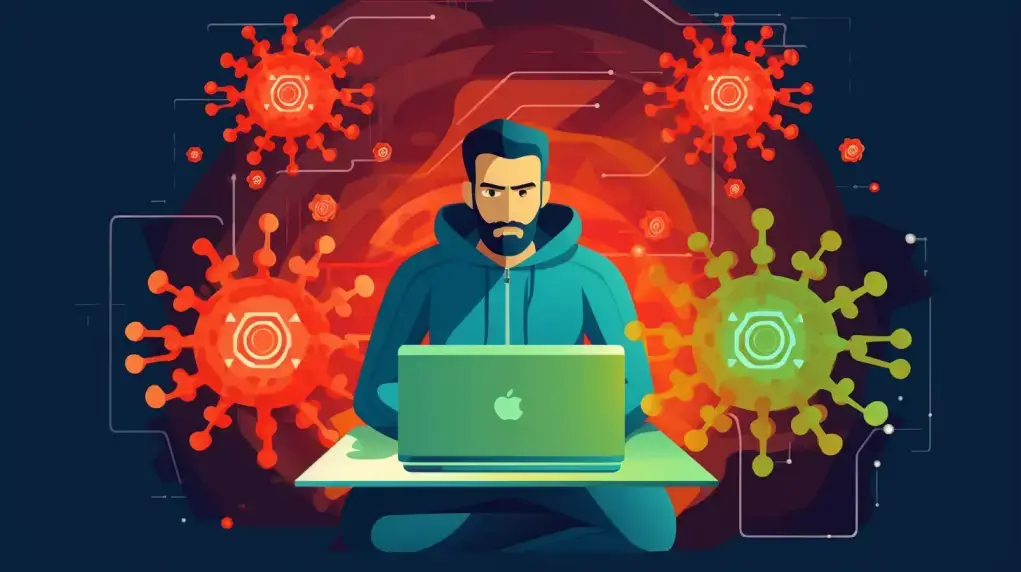
Introduction
Did you know that 86% of cybercriminals use evasion techniques to bypass traditional antivirus software? Next-generation antivirus offers a revolutionary approach to security that addresses this critical vulnerability.
While conventional solutions rely on outdated signature-based detection, AI-based antivirus systems can process millions of data points per second to identify threats in real-time. Additionally, a Ponemon survey revealed that 80% of compromised organizations reported the attack was a new or unknown zero-day attack, precisely the type of threat traditional antivirus struggles to detect. Machine learning antivirus technologies have gained significant traction, with 51% of enterprises now using AI and ML in their security solutions.
The difference between traditional antivirus vs next next-generation antivirus is striking. What is next-generation antivirus exactly? It’s a security approach that deploys in hours instead of months, automatically responds to potential incidents, and continuously learns from new data. This guide will show you why upgrading your security posture with next-gen solutions is no longer optional but essential for protecting your digital assets against increasingly sophisticated threats.
Traditional Antivirus vs Next-Generation Antivirus
The fundamental differences between traditional and next-generation antivirus solutions extend far beyond simple feature comparisons. When examining these security approaches side by side, three critical aspects stand out: detection methodology, response capabilities, and adaptability to emerging threats.
Detection methods: Signatures vs behavior
Traditional antivirus software operates primarily through signature-based detection, comparing files against a database of known malware signatures. These signatures are unique data strings or code sequences characteristic of specific malware. Once identified, the system flags matching files as malicious. However, this approach has a significant limitation – it only works effectively against previously cataloged threats.
In contrast, next-generation antivirus employs behavioral analysis to monitor system activities in real time. Rather than simply looking for known malicious code, NGAV examines how files and applications behave within your system. This behavioral approach allows NGAV to identify suspicious activities that might indicate an attack, even if the specific malware variant has never been seen before.
According to research, traditional antivirus systems struggle particularly with fileless attacks, memory-based attacks, and PowerShell scripting exploits. Furthermore, signature-based detection requires constant updates to remain effective against new threats – a reactive approach that creates security gaps.
Response time and automation
The response capabilities of these solutions differ dramatically. Traditional antivirus typically requires manual intervention to address detected threats. Users must schedule scans, wait for results, and manually initiate remediation efforts.
Next-generation antivirus, on the other hand, features automated response capabilities that execute predefined actions when threats are detected. These actions might include killing malicious processes, quarantining infected files, or isolating compromised endpoints from the network. This automation significantly reduces response time and minimizes potential damage.
The deployment process also highlights key differences. Traditional antivirus solutions often require hardware installation on-site, with average deployment taking approximately three months. Conversely, cloud-based NGAV solutions can be fully implemented within hours, providing immediate protection against emerging threats.
Adaptability to new threats
Perhaps the most critical difference lies in how these solutions adapt to new threats. Traditional antivirus relies on regular signature updates to recognize new malware variants. This creates an inherent vulnerability – according to a Ponemon survey, 80% of respondents who had been compromised reported that the attack was a new or unknown zero-day threat.
Next-generation antivirus leverages machine learning and AI to continuously improve its detection capabilities. This technology enables NGAV to:
-
Identify unknown threats using predictive modeling
-
Adapt to new attack techniques without requiring updates
-
Detect sophisticated attacks like fileless malware and ransomware
-
Minimize false positives through advanced analysis
The time factor is particularly significant in security breaches. With traditional solutions, the average dwell time (from breach to detection) is approximately 90 days. NGAV dramatically reduces this window through continuous monitoring and rapid threat identification.
For organizations weighing security options, understanding these fundamental differences is crucial for developing an effective defense strategy against today’s increasingly sophisticated cyber threats.

Why AI-Based Antivirus is the Future
Artificial intelligence represents a quantum leap in cybersecurity capabilities, offering protection that traditional solutions simply cannot match. The cybersecurity landscape has become an arms race where next-generation antivirus powered by AI provides the decisive advantage.
Real-time learning and threat prediction
AI-based antivirus systems constantly analyze system behavior in real time, enabling them to spot suspicious activities as they occur. Unlike traditional solutions that wait for scheduled scans, next-gen antivirus monitors continuously and responds instantly when potential threats appear.
These systems excel through advanced pattern recognition capabilities. AI detects anomalies in system behavior that might indicate an attack, flagging unusual activity that could signal compromise. Moreover, this real-time monitoring allows for immediate intervention, dramatically reducing the window of vulnerability compared to traditional solutions.
Predictive analytics represents another game-changing capability of AI-based antivirus. By analyzing trends and patterns, these systems can anticipate potential threats before they materialize. Essentially, this shifts security from reactive to preventive, stopping threats before they can execute their payloads. When suspicious activity is detected, AI can take swift automated actions:
-
Killing malicious processes before damage occurs
-
Isolating affected systems to prevent lateral movement
-
Blocking network connections to halt command-and-control communications
-
Applying automated patches to close security gaps
This machine-speed response capability means threats can be neutralized in milliseconds rather than the hours or days required with human intervention.
Zero-day and unknown malware detection
Perhaps the most compelling advantage of next-gen antivirus is its ability to detect zero-day vulnerabilities, security flaws unknown to developers until exploited. Traditional signature-based detection fails completely against these threats since, by definition, no signatures exist for them.
AI overcomes this limitation through behavioral analysis. Rather than searching for known attack patterns, machine learning antivirus examines how applications and networks behave, spotting deviations from normal activity. This approach allows it to identify malicious intent even in code it has never encountered before.
The statistics speak volumes about this capability. When Beryllium Security tested their AI-powered Deep Application Profiler against a custom-coded malicious file, the system immediately identified its threatening behavior while 66 mainstream antivirus engines missed it completely. Likewise, an ML-based ransomware detection model achieved 93% accuracy in detecting never-before-seen ransomware.
Continuous improvement through data
Unlike traditional solutions that require manual signature updates, artificial intelligence antivirus continuously evolves through learning. Each new threat encountered becomes part of the knowledge base, making the system increasingly effective over time.
This learning process happens across multiple dimensions. Cloud-based AI solutions analyze vast amounts of data across numerous organizations, reducing detection time for emerging threats. Furthermore, some vendors have built sophisticated machine-learning pipelines that can train and deploy new malware detection models within just 12 hours.
The scale of this protection is remarkable. One leading vendor reports blocking 132 million ransomware attacks in a single year and stopping approximately 2 billion attacks monthly. Additionally, many systems now incorporate Retrieval-Augmented Generation (RAG) technology that treats threat intelligence as natural language, allowing incredibly fast sharing and distribution of threat profiles worldwide.
For organizations, the benefits extend beyond better protection. AI-powered threat prevention reduces false positives by distinguishing and ignoring non-threatening activities. Consequently, security teams can focus on strategic initiatives rather than chasing false alarms, while minimizing the disruption of legitimate business activities.

Top Features of Next-Gen Antivirus
The technical architecture behind next-generation antivirus solutions creates a defensive framework far more sophisticated than conventional security tools. These innovative features work together to deliver protection that adapts to emerging threats without compromising system performance.
Cloud-based lightweight agents
Next-generation antivirus solutions utilize a cloud-based architecture that fundamentally changes how security operates on your devices. Unlike traditional solutions that install bulky software packages, NGAV deploys a single, lightweight agent that minimizes impact on endpoint performance. This architectural shift allows you to maintain robust security without sacrificing computing power for day-to-day operations.
The installation process has been dramatically streamlined as well. Specifically, cloud-based NGAV solutions install in seconds rather than hours, with some solutions taking up just a few megabytes of hard drive space. This minimal footprint enables rapid deployment across entire organizations without the traditional delays associated with security rollouts.
Most compelling is how these lightweight agents maintain continuous protection. Because threat intelligence resides in the cloud rather than on local devices, your security remains current without consuming valuable system resources.
Machine learning antivirus engines
The core of next-generation antivirus technology lies in its advanced machine learning capabilities. These sophisticated engines analyze millions of file characteristics in real-time to determine if content is malicious, even without prior exposure to specific threats.
Notably, these engines incorporate various machine-learning approaches:
-
Deep learning neural networks that detect known and unknown malware without signatures
-
Specialized models built for specific file types commonly exploited by attackers
-
Stacked ensemble classifiers that combine multiple models for more accurate predictions.
Some leading vendors have achieved perfect 100% efficacy with zero false positives in independent testing, demonstrating the exceptional accuracy of these systems. Furthermore, certain machine learning engines now provide confidence levels with their analyses, giving you greater insight into potential threats.
Exploit blocking and IOA detection
Next-generation antivirus solutions actively track the techniques attackers use rather than just looking for malicious files. This approach, known as exploit prevention, blocks the abuse of software vulnerabilities before attacks can progress.
Primarily, these systems monitor for Indicators of Attack (IOAs) – behavioral patterns that signal malicious activity in progress. By recognizing these patterns, NGAV can stop an attack even when using techniques never seen before. The integration of AI into IOA detection has yielded significant improvements, including faster detection, automated prevention, and fewer false positives.
No need for manual signature updates
One of the most practical advantages of next-generation antivirus is eliminating the burden of manual signature updates. NGAV solutions use signatureless technology to identify threats without relying on traditional signature databases.
As a result of this architectural shift, protection remains current automatically without scheduled updates or maintenance windows. This continuous protection works equally well whether endpoints are connected to the network or operating offline, ensuring consistent security across all environments.
Even for unpatched devices with known vulnerabilities, next-generation antivirus provides an additional layer of protection by blocking exploitation techniques, giving you valuable time to implement proper patches without compromising security.
Real-World Use Cases and Success Stories
The numbers speak volumes about next-generation antivirus adoption across organizations of all sizes. From enterprise-level corporations to small businesses, real-world implementations reveal compelling success stories that highlight the practical advantages of these advanced security solutions.
Enterprise adoption trends
Cybercrime damages have been estimated to surpass USD 10.5 trillion annually by the mid-2020s, pushing organizations to adopt more sophisticated protection strategies. With enterprises facing average losses of USD 4.45 million per data breach, investing in next-generation antivirus solutions is becoming increasingly vital for long-term financial security.
Throughout various industries, NGAV adoption continues to accelerate. Financial institutions utilize AI-based antivirus solutions to detect fraud and ensure regulatory compliance. Similarly, healthcare organizations implement these systems to safeguard sensitive patient data while maintaining HIPAA compliance. Retail and government sectors have likewise embraced NGAV to protect customer information and critical infrastructure.
Examples of NGAV stopping major attacks
Next-generation antivirus has proven effective against some of the most sophisticated cyber threats. Consider the Stuxnet attack on Iranian nuclear facilities, malware transferred via USB devices damaged more than 2,000 centrifuges and delayed their nuclear program by up to 2 years. Modern endpoint controls would have prevented this attack by blocking unauthorized USB devices.
In another case, Darktrace’s AI-powered security system detected and neutralized a ransomware attack targeting a healthcare organization before it could encrypt critical data. Woodside Energy successfully leveraged IBM Watson to analyze unstructured security data, enhancing its protection of critical infrastructure.
How small businesses benefit from NGAV
Small businesses face disproportionate cybersecurity risks, with 52% of SMBs suffering cyberattacks in 2021. More alarmingly, 60% of small businesses close within six months following a malware attack.
For smaller organizations, next-generation antivirus offers crucial advantages. Most NGAV solutions are cloud-based and deploy quickly to multiple devices from a single location. These lightweight systems protect endpoints without degrading performance. Small businesses particularly benefit from ransomware protection, as this represents their most significant cyber threat.
The cloud-based nature of NGAV means your small business can implement enterprise-grade security without requiring specialized IT staff. This accessibility helps explain why 82% of SMBs report experiencing cyberattacks that traditional antivirus failed to catch.
Preparing for the Future of Endpoint Security
Implementing robust endpoint security requires strategic planning and forward-thinking. As cybersecurity evolves at breakneck speed, your approach to protection must adapt alongside emerging threats.
Implementing NGAV in your environment
Zero-trust architecture forms the foundation of effective next-generation antivirus deployment. The zero-trust security market has grown to exceed USD 67.90 billion, highlighting its critical role in modern security frameworks. Initially, focus on implementing strict access controls that verify every device and user before granting system access.
For most businesses, cloud-based deployment offers the most efficient implementation path. Cloud-native NGAV solutions can be fully operational within hours without requiring additional hardware or infrastructure investments. This approach eliminates the burden of maintaining signature databases and managing complex infrastructure.
Small to medium businesses should prioritize “set and forget” solutions with automation and simplified cloud management. This approach provides robust protection without adding complexity or straining limited IT resources.
Training teams for AI-driven tools
Human error remains responsible for over 80% of cybersecurity incidents, making continuous security training essential. Develop regular, ongoing awareness programs that keep your team informed about emerging AI-powered threats like deepfakes, which occur every five minutes in 2024.
In reality, training must extend beyond awareness to include practical skills for working alongside AI security tools. Teams need to understand the “why” behind AI-driven security decisions rather than blindly following automated recommendations.
Staying ahead of AI-powered cyber threats
AI has dramatically accelerated attack speeds, with breakout times now frequently under one hour. Subsequently, your defensive strategy must incorporate AI-powered tools that can analyze vast amounts of data in real time to identify anomalies and potential breaches.
Be aware that cybercriminals increasingly use AI to craft highly convincing phishing emails, create deepfake videos, and develop malware that adapts to defensive measures. Identity-related vulnerabilities increased by 39.4% in 2024, making robust identity management crucial.
Above all, balance the benefits of AI security tools with appropriate human oversight. Implement policies governing AI tool usage, conduct regular audits, and ensure all AI applications comply with your organization’s security standards.
Conclusion
Traditional signature-based security simply cannot keep pace with today’s sophisticated cyber threats. Next-generation antivirus stands out as the clear winner through its AI-powered detection capabilities, behavioral analysis, and real-time response mechanisms. Additionally, the cloud-based architecture of NGAV solutions provides comprehensive protection without compromising system performance or requiring constant manual updates.
The numbers tell a compelling story. With 80% of compromised organizations falling victim to zero-day attacks and 86% of cybercriminals using evasion techniques, your security strategy must evolve beyond reactive measures. NGAV solutions deploy within hours instead of months, automatically respond to threats, and continuously learn from new data to strengthen your defenses against emerging attack vectors.
Small businesses particularly benefit from next-gen security, given that 60% close within six months following a malware attack. Regardless of your organization’s size, implementing NGAV represents a critical investment rather than an optional upgrade. The lightweight agents, machine learning engines, and exploit-blocking capabilities work together to create a security posture that adapts as quickly as threats evolve.
As AI-powered attacks continue to accelerate, your defensive strategy must match this sophistication. Next-generation antivirus doesn’t just protect your current assets; it prepares you for tomorrow’s security challenges through continuous improvement and intelligent threat detection. The transition from traditional to next-gen security isn’t just advisable, it’s essential for survival in our increasingly complex digital landscape.
FAQ
What are the key differences between traditional antivirus and next-generation antivirus?
Next-generation antivirus uses behavioral analysis and AI to detect threats in real time, while traditional antivirus relies on signature-based detection. NGAV offers automated responses, faster deployment, and better adaptability to new threats.
How does AI-based antivirus improve threat detection?
AI-based antivirus uses machine learning to analyze system behavior, predict threats, and detect zero-day vulnerabilities. It continuously learns from new data, improving its ability to identify unknown malware and reduce false positives.
What are the main features of next-generation antivirus solutions?
Key features include cloud-based lightweight agents, machine-learning antivirus engines, exploit blocking, and automatic protection updates without manual signature updates. These features provide robust security with minimal impact on system performance.
How can small businesses benefit from next-generation antivirus?
Small businesses can implement enterprise-grade security without specialized IT staff using cloud-based NGAV solutions. These systems offer quick deployment, ransomware protection, and effective defense against cyber threats that often lead to business closure.
How should organizations prepare for the future of endpoint security?
Organizations should implement zero-trust architecture, deploy cloud-based NGAV solutions, train teams on AI-driven tools, and stay informed about emerging AI-powered threats. Balancing AI security tools with human oversight is crucial for maintaining robust cybersecurity.






